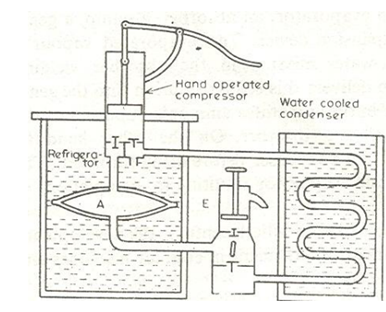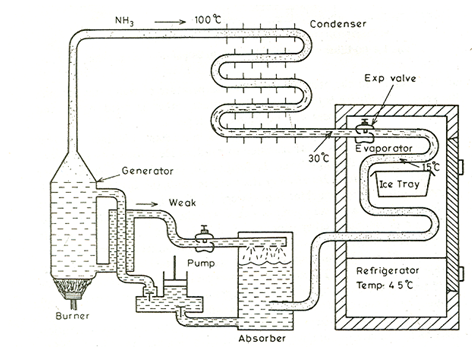History Of Refrigeration:
In the past approximate 4000 years from now, people in India & Egypt are known to generate ice by keeping water in the porous pots outside the home throughout the night period. The evaporation of water in almost cool dry air & radiative heat transfer among the water & the deep sky which is at a very low temperature (much below the freezing pt. of ice) caused the creation of ice even though the surrounding air was at a higher temperature than the freezing pt of water. There are a few accounts in China regarding the use of ice around 1000 BC for cooling the beverages. In 4th century A.D., East Indians were generating ice through dissolving salt in water.
Because of the very little amount of manufacture, the aforesaid technique was not feasible for commercial applications. Natural ice is restricted to definite regions; so, the absence of high quality insulation systems in those days forced the man to build up methods to create ice artificially. Out of several pioneers' work on refrigeration side, a few are presented here. In the year 1790 the first British Patent was attained by Thomas Hariss and John Long. In the year 1834 Jacob Perkins made a hand operated refrigeration system by using ether as the working fluid shown in figure. Ether vapour was sucked up by the hand operated compressor & then high temperature & pressure ether vapour was compacted in the water cooled chamber that served as the condenser. Liquid ether was at last throttled to the lower pressure that was then evaporated in a chamber called up evaporator, A. Along the evaporation, temperature of the water nearby the evaporator fell down and at last the ice was built. In this system, either was utilized again & again in the cyclic procedure with negligible wastage.

Schematic of the Hand-Operated Refrigeration Machine of Jacob Perkins
The initial American patent of a cold air machine to generate ice to cure people suffering from high fever was got by Dr. John Gorrie of Florida in year 1851. In the year of 1860, rather than air or ether, Dr. James Harrison of Australia utilized sulfuric ether. it was the world's initial installation of refrigeration machine for brewery. In the year 1861, Dr. Alexander Kirk of England manufactured a cold air machine same to that of Dr. Gorrie. In his Conditioning machine, air was compressed through a reciprocating compressor driven via a steam engine running on coal.
In the 19th century, there was remarkable growth of refrigeration process to replace natural ice by artificial ice manufacturing machines. In the start of the 20th century, huge sized refrigeration machines were manufactured. In the year of 1904 in the New York Stock Exchange, approximate 450 ton cooling machine was installed. In Germany, people utilized air conditioning in theater. Around the year of 1911 the compressors having speed between 100 to 300 rpm were formed. In the year 1915, the first two-stage modern compressor was formed.
To fulfil the demand for ice throughout the civil war, Ferdinand Carre of the USA manufactured a vapor-absorption refrigeration system shown in figure by using ammonia & water. Carre's system consisted of an evaporator, a pump, an absorber, a generator, a condenser & an expansion device. The evaporated vapour is absorbed by the week ammonia-water mixture in the absorber yielding strong aqua ammonia. The pump delivers this solution into generator where heat transfer from a burner separates ammonia vapour & the weak ammonia returns to the absorber. Conversely the ammonia vapour condenses in the condenser before being throttled. The throttled liquid ammonia enters into the evaporator resulting in finishing of the cyclic procedure.

Vapor-Absorption Machine of Ferdinand Carre
Until approximate the year 1920s the development in refrigeration system was limited to the refinement in vapour-compression systems & the cold-air machines. After the year 1920s, there has been wide diversification in the development of refrigeration systems leading to new creation such as thermoelectric, vortex tube, steam-jet, centrifugal compression systems, pulse-tube, etc. The most significant development may be the invention of new refrigerants that were chlorfluor hydrocarbons. This development occurred in the year 1930 in GE Corporation of USA at a time while Refrigeration industry had started to stagnate on the use of NH3 SO2 like refrigerant. The chlorfluor carbons offered the reward of best refrigerants & were proven non-toxic substances in comparison with NH3 and SO2
Other development took place because of special requirements to use waste heat or low grade energy or materials of particular properties for thermoelectric effect. Owing to the likelihood of energy crisis in the future, various commercial units have been created which utilizes waste heat or solar energy.